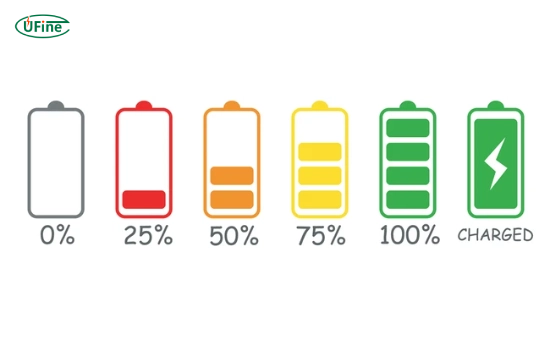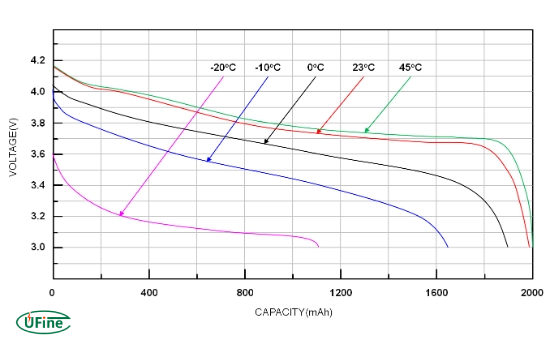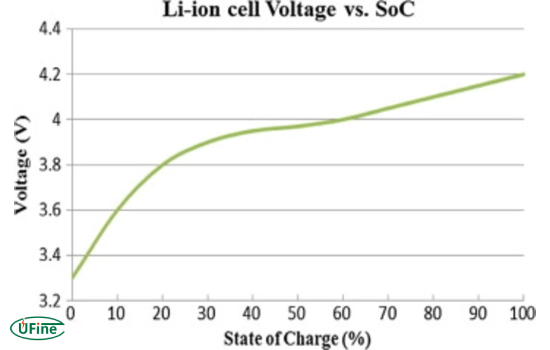Rechargeable batteries are essential for various devices, from smartphones to electric vehicles. Understanding the relationship between percentage, voltage, and state of charge (SoC) is crucial for effectively managing and maintaining these batteries. This article will explore the differences between these three key concepts and how they relate to rechargeable batteries’ overall performance and lifespan.
Part 1. What is the percentage of rechargeable batteries?
The percentage of a rechargeable battery refers to the amount of charge remaining in the battery compared to its total capacity. It is typically expressed as a value between 0% and 100%, with 0% indicating a wholly discharged battery and 100% indicating a fully charged battery.
Various methods can determine the percentage of a battery, such as:
- Voltage-based estimation: This method uses the battery’s voltage to estimate its state of charge. However, it can be inaccurate due to factors like cell materials and temperature affecting the voltage.
- Coulomb counting: This method involves tracking the current flowing in and out of the battery by integrating it during use. It provides a more accurate measurement of the battery’s state of charge.
Part 2. What is the voltage in rechargeable batteries?
Voltage is a fundamental electrical measure that indicates the electric potential difference between two battery points. It determines the amount of electrical force the battery can deliver to a circuit.
The higher the voltage, the more power the battery can provide to a device. Different battery chemistries, such as lead-acid and lithium-ion, have varying voltage ranges and discharge curves.
For example, a 12V lead-acid battery has a voltage range of approximately 10.5V (fully discharged) to 12.7V (fully charged). In contrast, a 12V lithium-ion battery has a voltage range of around 10V (fully discharged) to 12.6V (fully charged).
Part 3. What is battery state of charge (soc)? (detailed guide with examples)
Battery State of Charge (SoC) is the percentage of energy remaining in a battery relative to its full capacity. It acts as a “fuel gauge” for your battery, providing critical information for efficient energy management and longevity. SoC is expressed as a percentage, and accurate measurement requires advanced techniques, such as voltage correlation or coulomb counting.
The SoC is crucial for monitoring battery health and performance. It helps efficiently manage battery usage, ensure longevity, and prevent over-discharge, which can harm the battery’s lifespan.
Battery State of Charge and Battery State of Health
Part 4. Relationship between percentage, voltage, and SoC in rechargeable batteries
Understanding the relationship between percentage, voltage, and state of charge (SoC) is essential for anyone using rechargeable batteries, especially for beginners. Here’s a more precise breakdown of how these three concepts interact:
1. Percentage and SoC
The percentage of a battery directly reflects its state of charge (SoC). When we say a battery is at 50%, half of its total capacity is available for use. So, if a battery has a total capacity of 100 amp-hours (Ah), a 50% SoC indicates that 50 amp-hours remain. This relationship is straightforward: the percentage represents the SoC.
2. Voltage as an Indicator
Voltage serves as an indirect indicator of both percentage and SoC. Each type of rechargeable battery has a specific voltage range corresponding to its charge state. For example, a fully charged lithium-ion battery typically shows a voltage of around 4.2 volts per cell. In comparison, a fully discharged cell might drop to about 3.0 volts. Therefore, one can estimate the battery’s percentage and SoC by measuring the voltage. However, this estimation can vary based on temperature and battery age.
3. Voltage and SoC Correlation
The relationship between voltage and SoC is not linear. This means that a slight change in voltage can represent a significant change in SoC at specific points of the discharge curve. For instance, a battery’s voltage may remain relatively stable between 40% and 80% charged, but it can drop sharply as it approaches 20% or below. This characteristic is crucial for understanding when a battery is nearing depletion.
4. Practical Example
Consider a lithium-ion battery in a smartphone. The battery might read 4.2V when fully charged, representing 100% SoC. As you use the phone, the voltage gradually decreases. At around 3.7V, the battery might still be at about 50% SoC. However, as the voltage approaches 3.3V, the percentage may drop to around 20%, signaling that the battery is nearing depletion and needs recharging soon.
State of Charge (SoC) vs. Lithium-ion Voltage:
| State of Charge (SoC) | Lithium-ion Voltage (per cell) |
|---|---|
| 100% | 4.2V |
| 80% | 4.0V |
| 50% | 3.7V |
| 20% | 3.4V |
| 0% | 3.0V |
5. Importance of Monitoring
Monitoring both voltage and percentage/SoC is essential for effective battery management. Relying solely on voltage can lead to inaccurate assessments of how much usable energy remains, especially if the battery is aging or experiencing temperature fluctuations. Therefore, combining these measurements provides a more accurate picture of the battery’s health and remaining capacity.
How to Measure Battery State of Charge (SoC) Accurately?
- Voltage Correlation Method
– Measure the battery voltage using a multimeter and compare it against a voltage-to-SoC chart.
– Example: A lithium-ion battery at 4.2V is approximately 100% charged, while 3.0V represents near depletion. - Coulomb Counting Method
– Use advanced battery management systems (BMS) to track current flow in and out of the battery.
– Pro Tip: This method is more accurate for dynamic applications like EVs. - Impedance Spectroscopy
– For industrial or research purposes, measure impedance to assess SoC with high precision.
By combining these methods, users can maintain battery health and ensure longevity.
Part 5. Factors affecting percentage, voltage, and SoC
Several factors can affect the percentage, voltage, and SoC of rechargeable batteries, including:
- Battery chemistry: Different battery chemistries, such as lead-acid and lithium-ion, have varying voltage ranges and discharge curves.
- Temperature: Temperature can affect the battery’s voltage and SoC. Higher temperatures can increase the voltage, while lower temperatures can decrease it.
- Age and degradation: As batteries age and degrade over time, their maximum SoC starts to drop, meaning a 100% SoC for an old battery would be similar to a 75-80% SoC for a young one.
- Charging and discharging patterns: How a battery is charged and discharged can also impact its percentage, voltage, and SoC. Rapid charging or discharging can cause voltage drops and affect the battery’s overall performance and lifespan.
Part 6. Importance of accurately measuring percentage, voltage, and SoC
Accurately measuring the percentage, voltage, and SoC of rechargeable batteries is crucial for several reasons:
- Efficient battery management: Knowing the battery’s state of charge helps manage its usage efficiently, ensuring longevity and preventing over-discharge.
- Accurate performance monitoring: Tracking the battery’s percentage, voltage, and SoC allows for precise monitoring of its performance and health over time.
- Improved safety: Monitoring the battery’s state of charge helps prevent over-discharge or overcharging, maintains safety, and reduces the risk of fire or explosion.
- Extended battery life: Proper management of the battery’s percentage, voltage, and SoC can help extend its lifespan and maintain its optimal performance over time.
Part 7. Challenges in measuring percentage, voltage, and SoC
While measuring the percentage, voltage, and SoC of rechargeable batteries is essential, it also presents several challenges:
- Inaccuracies in voltage-based estimation: As mentioned earlier, voltage-based estimation can be inaccurate due to factors like cell materials and temperature affecting the voltage.
- Complexity of coulomb counting: While it provides a more accurate measurement of the battery’s SoC, it requires complex equipment and calculations.
- Variations in battery chemistry: Different battery chemistries have varying voltage ranges and discharge curves, making it challenging to develop a universal measurement system.
- Aging and degradation: As batteries age and degrade over time, their maximum SoC starts to drop, making it difficult to measure their state of charge accurately.
Part 8. Advancements in battery management systems (BMS)
Researchers have advanced Battery Management Systems (BMS) to address these challenges and monitor and manage rechargeable batteries’ percentage, voltage, and SoC. BMS typically includes features such as:
- Voltage monitoring: BMS monitors the voltage of individual cells or the entire battery pack to ensure that each cell is within the safe operating range.
- Current monitoring: BMS tracks the current flowing in and out of the battery pack to calculate the SoC using coulomb counting.
- Temperature monitoring: BMS monitors the battery pack’s temperature to ensure it operates within the safe temperature range and adjusts the charging and discharging parameters accordingly.
- Balancing: BMS balances the charge between individual cells in a battery pack to ensure that all cells have the same SoC, which helps to extend the battery’s lifespan.
Part 9. Future trends in battery percentage, voltage, and SoC measurement
As rechargeable batteries play a crucial role in powering our devices and vehicles, the need for accurate and reliable measurement of percentage, voltage, and SoC will only grow. Some future trends in this area include:
- Advancements in battery chemistries: New battery chemistries, such as solid-state batteries and lithium-air batteries, may offer improved energy density and safety, which could impact the way we measure their percentage, voltage, and SoC.
- Improved battery management algorithms: As BMS becomes more sophisticated, the algorithms used to measure and manage the battery’s percentage, voltage, and SoC will also improve, providing more accurate and reliable data.
- Integration with IoT and AI: The integration of Battery Management Systems (BMS) with Internet of Things (IoT) and Artificial Intelligence (AI) technologies could lead to more advanced battery monitoring and management systems that can predict battery failures and optimize battery usage based on user behavior and environmental conditions.
Part 10. FAQs on rechargeable battery percentage, voltage, and SoC
1. How do I check the percentage of my rechargeable battery?
You can check the percentage of your rechargeable battery using various methods, such as:
- Checking the battery indicator on your device: Most devices with rechargeable batteries, such as smartphones and laptops, have a battery indicator that displays the remaining battery percentage.
- Using a battery management app: Many apps are available that can provide more detailed information about your battery’s percentage, voltage, and SoC.
- Measuring the voltage: You can use a voltmeter to measure the voltage of your battery and then refer to a voltage-to-percentage chart to estimate its state of charge.
2. What is the difference between percentage and state of charge (SoC)?
A rechargeable battery percentage and state of charge (SoC) are closely related but different. The rate refers to the amount of charge remaining in the battery compared to its total capacity, typically expressed as a value between 0% and 100%. The SoC, on the other hand, is a more precise measure of the battery’s current energy level compared to its optimal capacity, also expressed as a percentage.
3. How do I know if my rechargeable battery is fully charged?
You can determine if your rechargeable battery is fully charged by checking the battery indicator on your device or using a battery management app. Most devices display a “100%” or “Full” indicator when the battery is fully charged. Additionally, you can measure the battery’s voltage using a voltmeter and refer to a voltage-to-percentage chart to confirm that the battery is at 100% SoC.
4. How can I extend the lifespan of my rechargeable battery?
To extend the lifespan of your rechargeable battery, you can:
- Avoid overcharging or over-discharging: Keeping the battery between 20% and 80% SoC can help extend its lifespan.
- Charge the battery at moderate temperatures: Avoid charging the battery in very hot or cold environments, as extreme temperatures can damage the battery.
- Use the battery regularly: Letting it sit for long periods without use can cause it to lose its charge and potentially degrade faster.
- Consider using a battery management system (BMS): BMS can help monitor and manage the battery’s percentage, voltage, and SoC, ensuring it operates within safe parameters and extends its lifespan.
5. What factors affect battery state of charge (SoC)?
The state of charge (SoC) can be influenced by:
- Battery Chemistry: Lithium-ion vs. lead-acid batteries have different SoC-voltage curves.
- Temperature: High temperatures may inflate voltage readings, while low temperatures can reduce voltage.
- Battery Age: Aging decreases the maximum capacity and affects the accuracy of SoC estimation.
- Usage Patterns: Frequent deep discharges can lower accuracy and battery health.
6. How to calculate battery SoC manually?
To calculate SoC manually:
- Measure the battery voltage using a voltmeter.
- Use a voltage-to-SoC chart specific to your battery type.
- For precise results, consider combining voltage readings with current measurements.
7. Why is SoC important for electric vehicles (EVs)?
SoC is critical for EVs as it ensures efficient energy usage, prevents range anxiety, and extends battery lifespan. Accurate SoC management can optimize performance and enhance safety.
Related Tags:
More Articles

How to Choose the Best Floor Scrubber Battery for Commercial Cleaning?
Selecting the ideal floor scrubber battery ensures a long runtime, rapid charging, and minimal maintenance for efficient commercial cleaning operations.
Battery for Blower vs Battery for Leaf Vacuum: Which One Should You Choose?
Battery for blower vs leaf vacuum—learn the key differences in power, fit, and runtime to choose the right battery for your outdoor tool needs.
How to Choose the Right Battery for Blower?
Choosing the right blower battery? Consider voltage, capacity, chemistry & usage. This guide helps match the best battery for peak performance.
How to Choose the Best Insulated Battery Box for Lithium Batteries?
Choosing the Best Insulated Battery Box for Lithium Batteries? Discover key factors such as size, material, and safety for optimal protection and performance.
7 Critical Elements on a Lithium Battery Shipping Label
What must be on a lithium battery shipping label? Learn 7 key elements to ensure safety, legal compliance, and correct handling across all transport modes.






